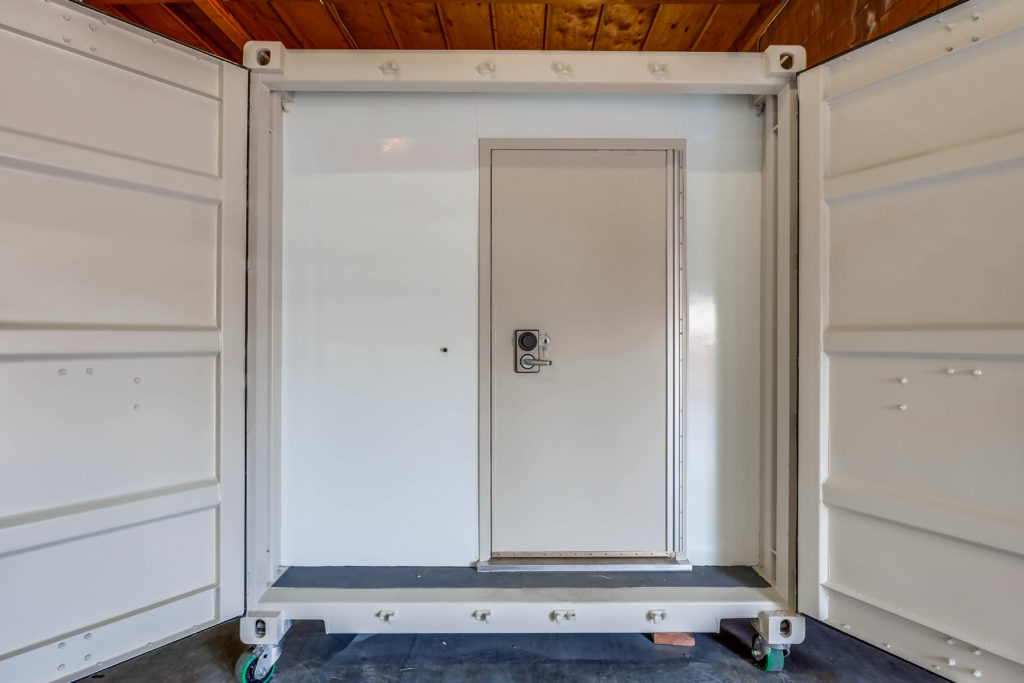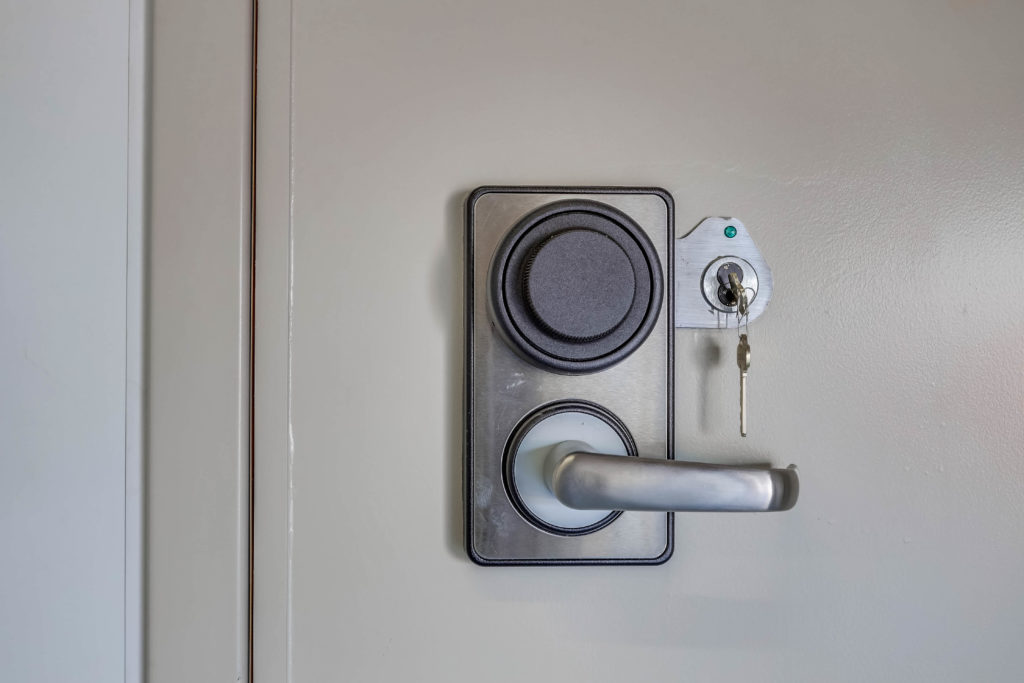An overview of the ICD 705 requirements for different types of STC doors in your secure facility
Your SCIF perimeter doors are an important barrier of security. They are where your personnel will access your SCIF, and they’re the first layer of your perimeter protection. If they aren’t installed properly, sound or radio frequency emanations can escape your SCIF, or someone could infiltrate your facility.
Because of this, the ICD 705 Tech Spec has several requirements that any doors at your perimeter must meet. These will apply not only to your primary entrance door, but also to several other door types.

Primary Door Requirements
Your primary entrance door is the door through which people will enter and exit your SCIF. You’ll only have one primary entrance, though V1.5 of the Tech Spec does now allow for a secondary entrance, with Accrediting Official (AO) approval. There are a few different options the Tech Spec lays out for your door composition: If you’re using wood, it must be 1¾-inch solid core wood stave or particle core, and for metal it must be 18 gauge and reinforced to 10 gauge where your lock is placed.
The doors require the same acoustic protection as your walls, whether that be STC 45 or 50. All your perimeter doors will need to meet these same composition standards. The two door types, wood and metal, will cost you about the same, but the metal door will not warp or flex the way a wood door might in humidity. Overall, a metal door will be more stable than a wood one.
The Tech Spec is also very specific on the types of locks you can use on your door. You need a deadbolt that meets Federal Specification FFL-2890. You also need a combination spin-dial lock that meets FFL-2740, and this is used to lock your door when the space is unoccupied. The primary entrance is the door where you’ll arm and disarm your alarm. For daytime use, your door must be secured by a two-factor access control system.
If the fire marshal allows it, in-swinging doors are more secure. Your door must be a grade one closer, which means it is rated for at least two million cycles, or uses, before the hardware breaks. The doors will also need a non-hold open closer, which means the door will close on its own. If the door hinges are accessible from outside the facility, they need to be modified to prevent removal.
We recommend ordering your doors with an interchangeable core. If you lose your keys, this allows you to change out the locks easily. Otherwise, someone finding those lost keys could pose a potential threat to your facility. Make sure you order your door as a rated assembly (i.e., door, frame and seals), as the STC rating may not be preserved if you try to piece those components together from various manufacturers. Also ensure your door is installed by a certified installer.
In the end, you can plan on your perimeter door costing around $15,000 including installation. If RF shielding is required for your secure facility, that will add approximately an additional $10,000 to $15,000.
Secondary Door Requirements
In version 1.5, the Tech Spec began to allow for a secondary entrance door. This has the same requirements as your primary entrance door, except it will not have the spin-dial lock, as you only want one door—the primary entrance door—to be where the facility is locked and unlocked.
A secondary door can be beneficial in a larger space because it makes it more convenient for employees to not have to traverse the entire SCIF to get to their workspaces. In facilities with a large number of employees frequently entering the space, it will also allow your main door to last longer without breaking, as it will decrease the number of daily cycles for the primary door and its hardware.
Because this is a newer allowance by the IC Tech Spec, your AO may be wary of approving a secondary entrance, so make sure you discuss it with them before you start the design phase on your secure facility.
Emergency Exit Door Requirements
Again, your emergency exit doors will need to have the same composition and acoustic protection as your primary entrance door. This door, however, must be alarmed 24/7. If the door is opened, an audible local alarm needs to go off.
These doors need to have deadlocking panic hardware for exit use only. These doors should have no exterior hardware. The requirement for them will be driven by Fire Life Safety.

Double Doors
These types of doors are useful when you need to move material through the facility that may be too large for a single door. At least one of the two doors must be a fixed leaf astragal secured with dead bolts with a combination lock. When cleared personnel aren’t actively moving materials, you should keep one leaf secured. Otherwise, someone may be able to access or remove large amounts of information surreptitiously. You cannot use a shared alarm contact for the two doors–each door must have its own. You can, however, get doors with a removable mullion, the bar between the doors, to make more space to move things through the doorway.
Roll-up Doors
Currently, there is no guaranteed STC 45 or higher roll-up door available on the market. You can still purchase quality roll-up doors that will give better noise control than a lower quality roll-up door. You can also add sound masking to prevent intelligible speech from being heard outside the SCIF/SAPF perimeter. However, if your space requires one of these doors, it must be in a non-discussion area.
All roll-up doors in SCIFs need to be a minimum of 18-gauge steel. They’ll also have to be secured with deadbolts and alarmed.
If you need a large opening that is rated STC 45 or higher, you will need to order a custom door. These can be very expensive, with price tags in the tens of thousands. They also require a much longer lead time than a standard roll-up door.
Vault Doors
Vaults are a less common occurrence in SCIFs today than they used to be, but there may still be some instances where they’re necessary. For instance, if you have a large-sized or large number of classified assets that need to be locked up overnight, they may not fit in a GSA-approved container. In this case, a vault would be useful.
A vault door should not be the primary entrance to your SCIF or used for day-in day-out access. If your AO says that you need a vault, ideally you should have a vestibule and separate access to it.
Vaults will come with a high price tag. Along with building the door itself, you also need to reinforce the walls, floor and ceiling. These doors also exceed the Tech Spec requirements, so if you don’t need a vault, it can be expensive overkill.
Doors Joining to Adjacent SCIFs
If you have a door in your facility that leads to another SCIF, both sides will need a deadbolt and alarms and must meet acoustic requirements for whichever facility has the highest requirement. There cannot be unilateral access from one SCIF into the other. There needs to be some form of access control. These are considered another type of perimeter door even though they lead to another secured space.
Fire Life Safety and ADA also have requirements for your facility doors, and your doors still need to meet the accessibility and safety requirements, even with the added security.
Your doors are your first line of defense, so there isn’t room for error. At Adamo, we have decades of experience in securing spaces, and our professionals can install your doors and offer a variety of other physical security services.




